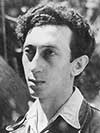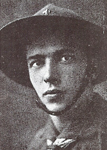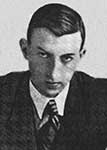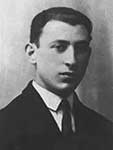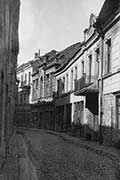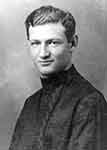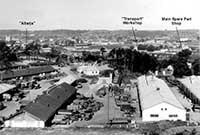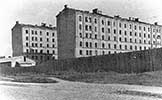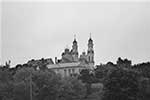| The official website of Until Our Last Breath: A Holocaust Story of Love & Partisan Resistance published by St. Martin's Press and maintained by author Michael Bart. |
The Escape to the Rudnicki Forest"I was brought to Lukiszki Prison...and bloodily beaten. All of us were taken out of our cells...loaded into...five or six big trucks. We were taken to a fenced in area called Ponar. We saw the prepared graves...there were hundreds and thousands there who had ended as we were to end. All the Jews were lined up. Men, women, and children were separated, and ordered to take off outer clothing. In front of the grave stood six Lithuanian soldiers with rifles. The victims were stood in rows of six. As soon as a row was arranged, a Lithuanian gave an order, there was a salvo, and six people fell into the grave. Another row of six were driven up, again shots, another falling of victims into the open grave. I know I fell to the ground and there was a heavy mass on me...of the murdered constantly falling into the big mass grave. It began to get dark. I crawled out of the grave. I was naked and covered in blood."1 The Creation of the Resistance Movement--F.P.O.
A young girl came back into the Vilna ghetto,
bleeding after escaping Ponary. She related her experience to a few
ghetto residents. She told of Jews in the forest being lined up at the edge a large pit and shot to death. Abba Kovner, a young charismatic poet heard her story
and took her warning to heart. However, most ghetto inhabitants did not believe that all the people who had left the ghetto
had been killed, it just didn't seem possible.2 At the beginning of 1941, the underground was established through Issac Wittenberg's leadership and Kovner's great vision. Abba Kovner gave his first proclamation
of resistance on January 1, 1942 in the ghetto's soup-kitchen located at the end of Strashun Street. Kovner stated,
During the period of relative calm the
Fareynegte Partizaner Organizatsye, referred to as the F.P.O., began to smuggle weapons into the ghetto in various ways. One way
The first act of sabotage was carried out by a trio of F.P.O. members on July 8, 1942 when a railroad line was mined damaging a train's engine and several of its compartments.7 As the underground organizations grew in the ghetto, there was a relatively peaceful co-existence between the Judenrat and the underground. However, Gens's attitude changed
On June 21, 1943, the ghettos in the Reichskommissariat Ostland were ordered to be liquidated by Heinrich Himmler. Jewish prisoners
fit for work were to be scheduled for deportation to work camps, and the rest were to be killed. German soldiers, along with Estonian collaborators surrounded the
After two days of waiting for the Germans to enter the street, a skirmish broke out between the underground, and the Germans and Estonian forces. In the exchange, Yechiel Scheinbaum stationed at the head of the street,
was shot, and killed instantly by a sniper. Standing next to M. Gurwitz,
Yechiel fell to the ground, and then a call came to get out of the building. Underneath them, the Estonians were setting
mines to their building. The group ran down stairs, and leapt out the back window minutes before the building was destroyed. With pending
nightfall and awareness of the undergrounds existence, the Germans retreated from the ghetto.13 M. Gurwitz retold the story of the shoot-out stating,
"Ilya Scheinbuam was killed next to me. When the Germans and Estonians entered into the ghetto, the FPO gathered together. We occupied the position at the beginning of the street on the second floor. We were ready to fight. We had rifles, explosives, and explosives with liquid fuel. Another group armed with a machine gun took the position on 6 Strashun, where the library, public bath, and prison courtyard used to be. The Estonians found out that we were armed. We saw through the window that the Estonians were retreating. When Scheinbaum saw them leaving, he leaned out the window and was killed by a bullet through his throat, and fell down. A sniper from below shot him. Then we got the order to retreat to 6 Strashun--there was no fire [from my position]. The ghetto was surrounded by Estonians. Our group leaped out the window."14 As total liquidation of the ghetto neared, beginning in August of 1943 the first lists of ghetto inmates were drawn up by Wehrmacht officer Major Karl Plagge for those eligible to work at Heeres Kraftahrpark, referred to as H.K.P.,
The day following the escape, a teenager wrote in his journal about the rumors he had heard. Although he refers to [Nathan] Ring as a part of the group of escapees leaving on September 15, Ring left with the second group to the forest.18 The teenager writes,
In total three groups of Yechiel's underground members escaped the ghetto before liquidation: on September 11th the first twenty five members were led by Y. Tshuzhoi, on the 13th the second group of thirty were led by E. Magid, and on the 15th the last group of fourteen were led by S. Brand. Five other groups of F.P.O. members also escaped at this time in route for the Naroch forest.20
At seven o'clock in the morning on September 23, 1943, the final liquidation began. The remaining sixty, some say eighty F.P.O. underground members that still remained in the ghetto
The remainder thirty-seven hundred prisoners from the ghetto at liquidation were sent to labor camps in Estonia
and Latvia; over four thousand women and children were sent to Sobibor extermination camp and were murdered.
During the selection as Rossa Square, the Missionaries Church at 20 Subocz Street, several hundred adults deemed unfit to work and children were taken from the square to Ponary to be shot. About twenty five hundred Jews
were left in Vilna, in the Kailis fur factory and Heeres Kraftfahrpark labor camp, and in two other smaller camps that provided labor
for the German war effort.22 In the words of one ghetto prisoner who ended up at Rossa Square at the time of the ghetto's liquidation,
During the two years of its existence, starvation, disease, street executions, maltreatment and deportations
to concentration camps and an extermination site on the outskirts of town called Ponary reduced the population
of the ghetto from an estimated 35,000 to zero. By mid-September of 1943, the ghetto had been completely liquidated.24
Back to Top The Escape from the Vilna Ghetto to the Rudnicki Forest"We saw ourselves in the F.P.O. as a Shomer collective, members of the HaShomer Hatzair movement...Far off, far off lies Vilna, bleeding, gray walls, empty gates, silent streets, empty...the day will come by the bonfires of the Merchavia (HaShomer Hatzair Kibbutz and center of the movement), someone will recount: about the days of mud and blood...and silently, that one will tell of the holy flames, of faith, of eternity! To battle and revenge! Chazak Ve'ematz" The remaining F.P.O. members escaped the last day of the final liquidation through the city's sewer system.
The group of fourteen who escaped out the side gate over a week prior drove by truck to Vilna's outskirts, then walked all night to the forest. The walk
Notes1. Kruk, The Last Days of the Jerusalem of Lithuania, 223 - 224.
2. Arad, Ghetto in Flames, 176.
3. Abba Kovner's proclamation is a combination of several translated versions. Kowalski, Isaac. A Secret Press in Nazi Europe, 82; Arad, Ghetto in Flames, 231 - 232. Kovner's testimony, ICJ, (12) 83 p. op. cit., 11; Arad's version of Kovner's testimony was taken from Kovner's article: "Nissayon Rishon," p. 11. The archives of Beit Lohamei ha-Getta'ot contain the Yiddish manuscript of the manifesto, with the caption "We must not go like sheep to the slaughter" (author's translation -- YA), bearing the date January 1, 1942. The manifesto extends 3 1/2 pages and its contents include the version of the manifesto drafted by Kovner, and additional items of appeal.
4. Kruk, The Last Days of the Jerusalem of Lithuania, 257 - 258, 268.
5. Arad, Ghetto in Flames, 264 - 8, 257; Shneidman, Three Tragic Heroes, 112.
6. C. Spanerflig videotaped interview 2004.
7. Kruk, The Last Days of the Jerusalem of Lithuania, 260 - 261.
8. Shneidman, Three Tragic Heroes, 125 - 126.
9. Shneidman, Three Tragic Heroes, 63 - 4; Gutman, Ed. Yitzhak Arad, The Encyclopedia of the Holocaust, 1574; Lazar, Destruction and Resistance: a History of the Partisan Movement in Vilna, 75 - 6.
10. Gutman, Ed. Yitzhak Arad, The Encyclopedia of the Holocaust, 1574.
11. Shames, "Memoirs of a Machine Gunner." Anthology on Armed Jewish Resistance, 401 - 402; Shneidman, Three Tragic Heroes, 72 - 74.
12. Shames, "Memoirs of a Machine Gunner." Anthology on Armed Jewish Resistance, 402.
13. Bart, Until Our last Breath, 287 - 288, note 6.
14. Videotaped interview with M. Gurwitz in the old ghetto, Vilnius 2005.
15. Irina Guzenberg, The HKP Jewish Labor Camp, 23; Gutman, Ed. Yitzhak Arad, The Encyclopedia of the Holocaust, 1574.
16. Dworzecki, Yeruschalayim D'Lita in Kamf un Umkum, 478 - 479; Lazar, Destruction and Resistance, 133.
17. Dworzecki, Yeruschalayim D'Lita in Kamf un Umkum, 478 - 479.
18. In a phone conversation F. Bulkin-Wolozni-Srebernik said that she and Meyer went with N. Ring's group and was in the forest at the time the third group consisting of L. Bart and Z. Lewinson-Bart arrived; Dworzecki, Yeruschalayim D'Lita in Kamf un Umkum, 478 - 479; Lazar, Destruction and Resistance, 133.
19. Unknown, Ed. Nathan Cohen. The Last Days of the Vilna Ghetto Jerusalem, Vad Vashem.
20. Dworzecki, Yeruschalayim D'Lita in Kamf un Umkum, 478 - 479.
21. Isaac Kowalski, A Secret Press in Nazi Europe, 263; Dworzecki, Yeruschalayim D'Lita in Kamf un Umkum, 479.
22. Gutman 1574; Ran 463.
23. Beker, Symphony on Fire, 58 - 9.
24. Gutman, Ed. Yitzhak Arad, The Encyclopedia of the Holocaust, 1574.
25. Lazar, Destruction and Resistance, 134.
26. Bart, Until Our Last Breath, 290, note 17.
27. Videotaped interview with F. Jocheles-Brancovski traveling by car June 2004 states, "Vitka told me, in September at the guard station Ruska and I distracted the German guards so that a large group of partisans could cross the bridge." It was raining really hard and the water level in the river was high.
28. Bart, Until Our Last Breath, 290, note 19.
29. Videotaped interview with C. Spanerflig, Borka Friedman's wife, June 2004 states, "...when Glazman left for the Narocz forest in August, no one knew what had happened to my husband [Borka Friedman]. The ghetto was getting worse and worse. Glassman realized that Borka Friedman was right. They collected a second group to go to the forest, and there they found out from some Poles how Borka Friedman's group perished."
30. The four groups were: Za Pobedu (To Victory), Smert Fashizmu (Death to Fascism), Borba (Struggle Group), Nekamah (The Avengers).
31. Bart, Until Our Last Breath, 292, note 13.
|
||||||||||||||||||||||||||||||||||
Forest - Page 4 of 6
